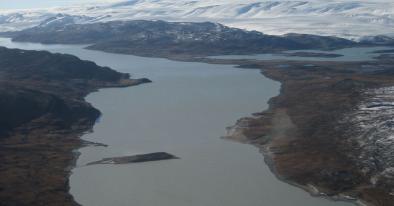Science Source
Causes of Greenland temperature variability over the past 4000 yr: implications for northern hemispheric temperature changes
- Investigates Greenland temperature variability over the past 4000 yr reconstructed from argon and nitrogen isotopes from trapped air in a GISP2 ice core, using a one-dimensional energy balance model with orbital, solar, volcanic, greenhouse gas, and aerosol forcings
- Finds the modelled northern Northern Hemisphere (NH) temperature exhibits a cooling trend over the past 4000 yr as observed for the reconstructed Greenland temperature through decreasing annual average insolation—the modelled and observed Greenland temperatures agree with consideration of the negative influence of solar variability
- Finds the model can explain 14 to 20 % of variance of the observed Greenland temperature in multidecadal to centennial timescales with a 90–96 % confidence interval, suggesting that a weak but persistent negative solar influence on Greenland temperature continued over the past 4000 yr
- Estimates the distribution of multidecadal NH and northern high-latitude temperatures over the past 4000 yr constrained by the climate model and Greenland temperatures
- Finds that estimated northern NH temperature and NH average temperature from the model and the Greenland temperature agree with published multi-proxy temperature records
- Finds that greenhouse gases played two important roles over the past 4000 yr for the rapid warming during the 20th century and slightly cooler temperature during the early period of the past 4000 yr
- Results indicate that the current average temperature (1990–2010) or higher temperatures occurred at a frequency of 1.3 times per 1000 yr for northern high latitudes and 0.36 times per 4000 yr for NH temperatures, respectively, indicating that the current multidecadal NH temperature (1990–2010) is more likely unprecedented than not (p = 0.36) for the past 4000 yr
Related Content
Science Source
| Geophysical Research Letters
Melting glaciers stimulate large summer phytoplankton blooms in southwest Greenland waters
Kevin R. Arrigo, Gert L. van Dijken, Renato M. Castelao et al
Science Source
| Geophysical Research Letters
Ice Core Records of West Greenland Melt and Climate Forcing
K. A. Graeter, E. C. Osterberg, D. G. Ferris et al
Science Source
| Science Advances
Abrupt shift in the observed runoff from the southwestern Greenland ice sheet
Andreas P. Ahlstrøm, Dorthe Petersen, Peter L. Langen et al
Headline

Dec 15, 2017 | Vox
Greenland's ice sheet is driving global sea level rise. One section is melting 80% faster.


